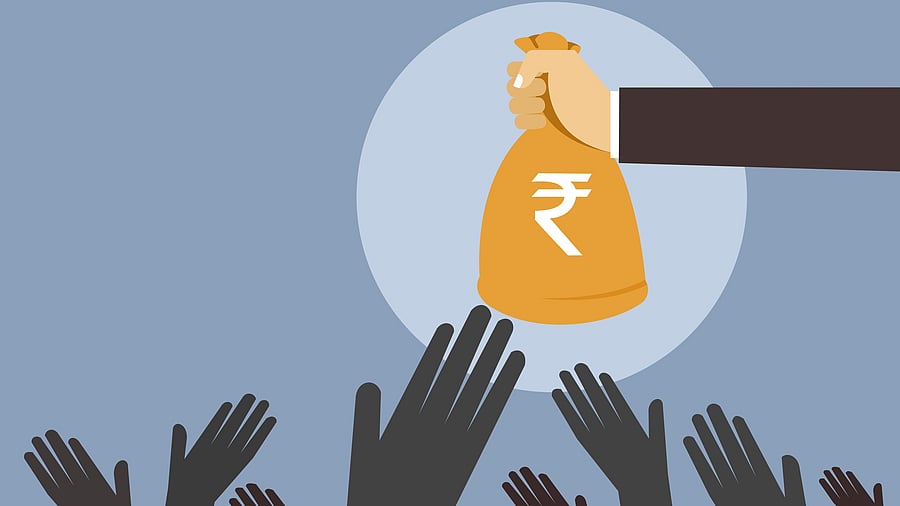
Representative image showing freebie being given.
Credit: iStock Photo
The recent assembly elections in Rajasthan, Madhya Pradesh, Chhattisgarh and Telangana witnessed massive competition between the Bharatiya Janata Party (BJP) and the Congress (with regional parties also joining in with gusto) in announcing populist fiscal giveaways/freebies.
On December 9, the Reserve Bank of India (RBI) came out with its annual report ‘State Finances: A Study of Budgets’ for 2023-2024. The report concluded that states’ finances are in good shape and highlighted the fact that the states had much lower fiscal deficits in 2021-2022 and 2022-2023 than permissible.
How is it that the state finances are in the pink of health despite the freebies' race to the bottom? Will the mad rush witnessed during the recent elections bust the states’ budgets?
Freebies have become all-pervasive
Tamil Nadu’s free mid-day meals scheme and Andhra Pradesh’s ‘one rupee a kg rice’ scheme were the earliest redistribution/welfare/freebies schemes. At that time, a lot of hue and cry was raised about the fiscal hollowness of these schemes, whereas schemes like the Integrated Rural Development Programme (IRDP), which supposedly promoted tiny enterprises, and the National Rural Employment Programme (NREP), which provided wage opportunity, were considered fiscally sound.
The scenario began to change nationally, particularly after the defeat of the AB Vajpayee government in the 2004 general elections. The Manmohan Singh government brought in the Mahatma Gandhi National Rural Employment Guarantee Act (MGNREGA) to provide 100 days of guaranteed wages to win the hearts and votes of millions of people. This was topped up by the farm loan waiver, which yielded handsome dividends for the Congress in the 2009 elections.
Welfare schemes, however, tend to lose their electoral edge in a few years. By the 2014 elections, MGNREGA had lost its appeal and the Narendra Modi-led BJP stomped into power, riding on a new set of promises.
The BJP government re-packaged many existing schemes, innovating their features, besides making them universal. These schemes — which included housing, toilets, gas connections, electricity connections, Ayushman Bharat and so on — topped up with the PM Kisan announced just before elections, created a massive support base of ‘Labharthis’ who voted enthusiastically in favour of the BJP in the 2019 elections.
These schemes too, which delivered during the first term (2014-2019), kept losing their appeal during the second term. The only new welfare scheme in the second term (2019-2024) — the Jal Jeevan Mission — has not been a mass success. This opened the freebies/welfare space for the Opposition.
The Aam Aadmi Party (AAP) designed an alternative package of welfare/freebies — it improved government schools, focused on better delivery of health services, water bill subsidies, electricity bill subsidies, and the like which was well-received by the people who gave it a massive mandate in the 2020 Delhi elections.
The Congress promised many cash hand-outs and higher subsidies, peppered with a reversion to the old pension scheme (OPS) in Himachal Pradesh and Karnataka elections which brought good electoral returns. The party implemented a still more strident version of these freebies in Rajasthan and pitched up the package, further garnished with higher procurement prices, aggressively for the five assembly elections held recently.
Realising the waning impact of the BJP package on its ‘Labharthis’ and the increasing appeal of the Congress’ guarantees, the BJP came out with a big package of freebies as ‘Modi Guarantees’, building on free ration to 800 million Indians and Madhya Pradesh’s ‘Ladli Behna’ scheme. These neutralised the Congress’ package.
Freebies have now become the national electoral passion with all political parties heavily invested in the game.
Structural constraints will not allow wracking of state finances
The earlier mentioned RBI report, based on provisional (as good as actuals) fiscal outcome, confirms that all the fundamental fiscal parameters for 2022-2023 for states were sounder than the prescribed fiscal responsibility indicators.
The states’ fiscal deficit, in aggregate, was sharply lower at 2.8 per cent of GDP in 2022-2023 than the permissible 4 per cent (the Union government ran a fiscal deficit of 6.4 per cent against the permissible 3 per cent).
The primary reason for this is that the states just cannot spend beyond their permissible fiscal deficit limits. The states face what is known as real hard budget constraints.
The states’ borrowing is primarily in the form of market securities, approved and strictly controlled by the Union government. Further, the RBI would not raise a single rupee of borrowing for them over the permitted limits.
The fiscal discipline is also much more internalised in and applied stringently by the state governments. They make their budgets based on permissible borrowing limits only.
The RBI report notes that states’ fiscal deficit was budgeted at 3.1 per cent of GDP (against permissible 3.5 per cent for the year) and a capital outlay at 2.9 per cent of GDP.
States will take new freebies announcements in their stride
The states’ own tax revenues have done well since 2021-2022. The devolution of central taxes has also improved significantly. The states have developed a good record of staying within their quota of permissible borrowing.
They will probably use their available resources for greater expenditure on welfare/redistribution/freebies/handouts, which is perfectly fine if they do not breach fiscal limits. If needed, the states will cut down on other revenue and capital expenditures.
There is almost no likelihood of the states’ actual fiscal deficit for 2023-2024 exceeding 3 per cent even if the states were to implement most of the poll promises.
Fears that the states could be busting their finances are unwarranted.
(Subhash Chandra Garg is former Finance & Economic Affairs Secretary, and author of ‘The Ten Trillion Dream’ and ‘We Also Make Policy’.)
Disclaimer: The views expressed above are the author's own. They do not necessarily reflect the views of DH.